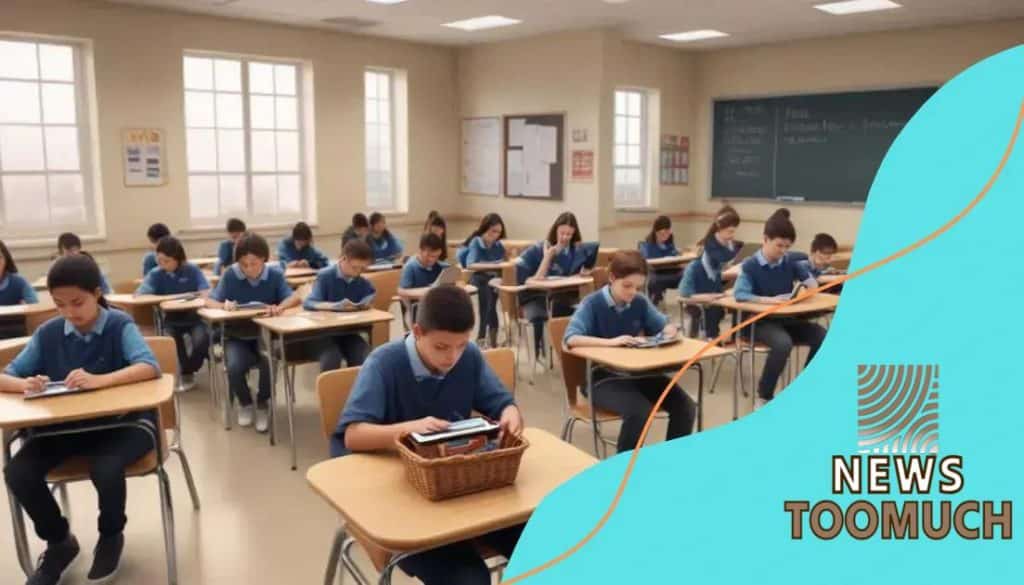Cellphone bans in US schools: What Will Happen and How to Deal With It

Cellphone bans in US schools are sparking debates across the country, as educators, parents, and students weigh the pros and cons of restricting mobile device use during school hours.
Are these policies truly effective in creating a better, more focused learning environment? Or do they risk limiting access to valuable digital tools?
Let’s explore the growing trend behind these decisions and examine the key reasons why many schools are moving toward stricter cellphone regulations, ranging from reducing distractions and cyberbullying to improving academic performance and classroom engagement.
The reasons behind cellphone bans
Understanding the reasons behind cellphone bans in schools is crucial for students and parents alike. As technology advances, many schools are questioning how cellphones affect learning.
One major concern is distraction. Cellphones can divert students’ attention from lessons, making it harder for them to focus.
Without the constant beep of notifications, students may engage more in their studies. This leads to better overall performance in the classroom.
Addressing behavioral issues
Moreover, schools aim to address a range of behavioral problems linked to excessive cellphone use.
When students are constantly distracted by their devices, texting, scrolling through social media, or playing games, it can lead to frequent disruptions that interfere with the flow of lessons and classroom discipline.
In these situations, teachers often struggle to maintain a productive and focused learning environment, as attention spans drop and student participation declines.
By implementing cellphone bans, schools hope to restore a sense of order and create a more harmonious atmosphere that supports concentration, respect, and academic engagement.
Creating a safe learning environment
Another significant reason for these bans is safety. In emergency situations, the reliance on cellphones can either cause panic or lead to misinformation.
Schools that enforce bans can manage situations more effectively. This not only keeps students safe but also helps maintain order during events or drills.
- Reduces overall distractions in the classroom
- Prevents potential bullying through social media
- Encourages face-to-face interactions among students
Lastly, many educators believe that limiting cellphone use in schools fosters better social skills. Students who rely less on their devices may develop stronger relationships with their peers.
This shift can improve collaboration and communication skills essential for their future.
Impact on student behavior and concentration
The impact on student behavior and concentration due to cellphone use in schools is significant. Many educators argue that constant access to mobile devices distracts students from their studies.
In classrooms where cellphones are allowed, teachers often notice that students have difficulty maintaining focus during lessons.
Notifications, messages, and social media updates pull their attention away from important learning opportunities. This divide can lead to a lack of engagement with the material being taught.
Behavioral challenges arising from cellphone use
Beyond mere distraction, cellphone use can lead to a range of behavioral issues that affect the entire classroom dynamic.
Many students develop a compulsive habit of checking their phones frequently, whether for notifications, messages, or social media updates, which not only disrupts their own focus but also distracts those around them.
These constant interruptions can fragment the learning process, making it harder for teachers to maintain structure and for students to stay engaged.
Over time, such disturbances contribute to a chaotic classroom atmosphere, reducing overall academic performance and diminishing the quality of the educational experience for everyone involved.
Benefits of reducing cellphone dependence
By implementing cellphone bans, schools aim to improve student behavior. A classroom free from the allure of smartphones allows students to engage more fully with the lesson.
They can develop a better understanding of the material and participate actively in discussions.
- Increased attention span during lessons
- Improved relationships among classmates
- Enhanced participation in group activities
Furthermore, the reduction in cellphone use promotes better concentration. Students are more likely to absorb information when they are not distracted by their devices.
With fewer interruptions, lessons can flow more seamlessly, leading to effective teaching and learning.
Alternatives to cellphone use in schools

Finding alternatives to cellphone use in schools is essential for fostering effective learning environments.
With the increased scrutiny on cellphone policies, educators are looking for ways to keep students engaged without their devices.
One effective alternative is the use of tablets and laptops in classrooms. These technologies can offer educational apps and tools while limiting distractions from social media and messaging.
With proper guidance, students can learn more effectively using these devices under teacher supervision.
Interactive learning methods
Another effective approach involves adopting interactive learning methods that actively engage students in the classroom.
By integrating group activities, discussions, and hands-on projects, teachers can redirect students’ attention away from their devices and back to their peers and the learning material itself.
This shift not only helps reduce reliance on cellphones as a source of stimulation but also fosters essential skills such as communication, teamwork, and problem-solving.
When students feel involved and connected to the learning process, they are more likely to stay focused and participate meaningfully, creating a more dynamic and collaborative classroom environment.
Encouraging outdoor activities
Additionally, schools can promote outdoor activities and physical education classes as alternatives. Engaging students in sports or outdoor learning experiences helps them stay active and develop teamwork skills.
These experiences provide a break from screens while still allowing students to have fun and learn.
- Incorporating more discussions into lessons
- Using educational games that don’t require phones
- Offering creative workshops in arts and crafts
Furthermore, implementing scheduled tech-free periods can help students reconnect with their surroundings and peers.
During these times, educators can lead discussions or activities that do not involve technology. This break from cellphones supports mental health and enhances social interactions.
The role of technology in education
The role of technology in education has evolved significantly, especially as schools consider restrictions on cellphone use. Technology, when used appropriately, can enhance the learning experience for students.
Tablets and computers have become valuable tools in the classroom. These devices allow for interactive lessons and immediate access to information.
Teachers can incorporate multimedia resources that capture students’ interest while providing a richer educational experience.
Enhancing student engagement
Furthermore, technology can boost student engagement. With the right apps and programs, teachers can create a more dynamic learning environment.
For instance, using educational games helps students grasp complex concepts in a fun way.
This shift not only motivates students but also encourages teamwork and healthy competition.
Access to online resources
Accessing online resources is another benefit of integrating technology into classrooms. Online platforms offer a wealth of knowledge, enabling students to explore topics beyond what is covered in textbooks.
This access encourages independent learning and critical thinking, vital skills for their future.
- Utilizing multimedia presentations to explain topics
- Encouraging collaboration through online tools
- Providing immediate feedback on assignments
However, using technology responsibly is crucial for maintaining focus. Schools are implementing guidelines that balance the use of devices with face-to-face interactions.
This balance ensures that technology complements traditional teaching methods rather than replacing them.
Parental perspectives on cellphone policies
Understanding parental perspectives on cellphone policies in schools is vital for nurturing a positive learning environment.
Parents often have varied opinions, depending on their experiences and beliefs about technology in education.
Many parents support cellphone bans in schools, believing that these policies reduce distractions and enhance learning.
They recognize that when students are not preoccupied with their devices, they can focus better on lessons and classroom discussions.
The concerns of parents
On the other hand, some parents express concern about the implementation of cellphone bans in schools.
They worry that restricting device use could hinder students’ ability to communicate quickly and access important information, both of which are increasingly vital in today’s connected world.
For instance, in the event of an emergency, whether personal or school-wide, students may need immediate access to their phones to contact parents or guardians.
These concerns raise important questions about how to strike the right balance between ensuring student safety and maintaining a focused, effective learning environment.
Finding common ground
To address these concerns, schools can engage parents in discussions about cellphone policies.
Open communication allows parents to voice their opinions and learn about the school’s reasoning behind these decisions. Collaboration between educators and parents ensures that both sides feel valued and heard.
- Parents can provide feedback on cellphone usage during school hours
- Schools can share data on the effects of cellphone bans on student performance
- Regular meetings can foster understanding and support for policies
Ultimately, navigating cellphone policies requires cooperation between parents, teachers, and students.
By working together, communities can create an environment where technology enhances education while addressing parents’ concerns.
Future trends in school policies regarding cellphones

The future trends in school policies regarding cellphones are becoming increasingly important as education evolves.
Many schools are reassessing their stance on cellphone use to better align with modern educational needs.
One trend is the integration of cellphones as learning tools, rather than banning them outright. Schools are developing policies that allow for supervised use during certain activities.
This shift acknowledges that, when used responsibly, cellphones can facilitate learning.
Blending technology with education
As technology continues to advance, more educators are exploring ways to thoughtfully incorporate cellphones into lesson plans rather than banning them entirely.
By leveraging the tools students already use daily, teachers can turn potential distractions into valuable learning aids.
For example, educators might integrate interactive quizzes, educational apps, or real-time research activities that students can access directly from their devices.
This approach not only encourages students to engage more actively with the material but also teaches them how to use technology responsibly and with purpose within an academic setting.
Establishing clear guidelines
Another trend involves establishing clear guidelines for cellphone use. Schools are focusing on creating comprehensive policies that outline when and how students can use their phones.
Improved communication about these guidelines helps students understand the expectations from the start.
- Creating smartphone usage agreements for students
- Offering training sessions for students on responsible use
- Incorporating cellphone-free time as part of the school day
Moreover, there is a growing recognition of the need for balancing technology with traditional teaching methods.
Schools may implement periods during the day where cellphones are not permitted to encourage more personal interactions and focus on learning without distractions.
FAQ – Questions about Cellphone Bans in US Schools
What is the main reason behind cellphone bans in schools?
The primary reason is to reduce distractions, allowing students to focus better on their studies.
How do cellphone policies impact student behavior?
Cellphone policies can improve behavior by minimizing disruptions during class and fostering better engagement with lessons.
Are there effective alternatives to cellphone use in classrooms?
Yes, alternatives include using tablets for educational apps, conducting group activities, and promoting tech-free periods.
How can parents get involved in cellphone policy discussions?
Parents can participate in school meetings, provide feedback on policies, and collaborate with educators to address concerns.





